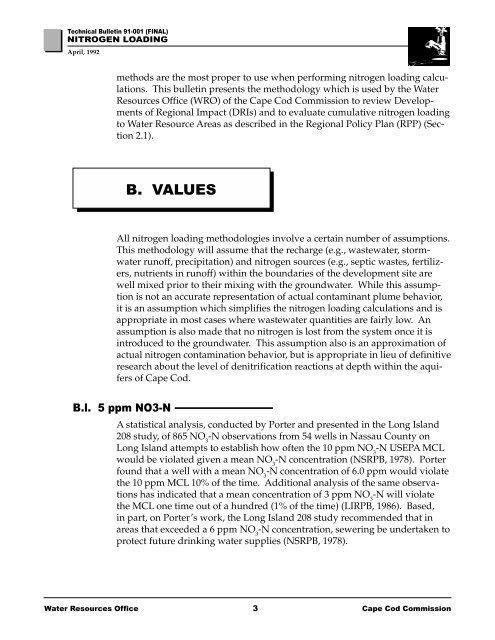Technical Bulletin 91-001 Nitrogen Loading - Cape Cod Commission
Technical Bulletin 91-001 Nitrogen Loading - Cape Cod Commission
Technical Bulletin 91-001 Nitrogen Loading - Cape Cod Commission
Create successful ePaper yourself
Turn your PDF publications into a flip-book with our unique Google optimized e-Paper software.
<strong>Technical</strong> <strong>Bulletin</strong> <strong>91</strong>-<strong>001</strong> (FINAL)<br />
NITROGEN LOADING<br />
April, 1992<br />
methods are the most proper to use when performing nitrogen loading calculations.<br />
This bulletin presents the methodology which is used by the Water<br />
Resources Office (WRO) of the <strong>Cape</strong> <strong>Cod</strong> <strong>Commission</strong> to review Developments<br />
of Regional Impact (DRIs) and to evaluate cumulative nitrogen loading<br />
to Water Resource Areas as described in the Regional Policy Plan (RPP) (Section<br />
2.1).<br />
B. VALUES<br />
All nitrogen loading methodologies involve a certain number of assumptions.<br />
This methodology will assume that the recharge (e.g., wastewater, stormwater<br />
runoff, precipitation) and nitrogen sources (e.g., septic wastes, fertilizers,<br />
nutrients in runoff) within the boundaries of the development site are<br />
well mixed prior to their mixing with the groundwater. While this assumption<br />
is not an accurate representation of actual contaminant plume behavior,<br />
it is an assumption which simplifies the nitrogen loading calculations and is<br />
appropriate in most cases where wastewater quantities are fairly low. An<br />
assumption is also made that no nitrogen is lost from the system once it is<br />
introduced to the groundwater. This assumption also is an approximation of<br />
actual nitrogen contamination behavior, but is appropriate in lieu of definitive<br />
research about the level of denitrification reactions at depth within the aquifers<br />
of <strong>Cape</strong> <strong>Cod</strong>.<br />
B.l. 5 ppm NO3-N<br />
A statistical analysis, conducted by Porter and presented in the Long Island<br />
208 study, of 865 NO 3<br />
-N observations from 54 wells in Nassau County on<br />
Long Island attempts to establish how often the 10 ppm NO 3<br />
-N USEPA MCL<br />
would be violated given a mean NO 3<br />
-N concentration (NSRPB, 1978). Porter<br />
found that a well with a mean NO 3<br />
-N concentration of 6.0 ppm would violate<br />
the 10 ppm MCL 10% of the time. Additional analysis of the same observations<br />
has indicated that a mean concentration of 3 ppm NO 3<br />
-N will violate<br />
the MCL one time out of a hundred (1% of the time) (LIRPB, 1986). Based,<br />
in part, on Porter’s work, the Long Island 208 study recommended that in<br />
areas that exceeded a 6 ppm NO 3<br />
-N concentration, sewering be undertaken to<br />
protect future drinking water supplies (NSRPB, 1978).<br />
Water Resources Office 3<br />
<strong>Cape</strong> <strong>Cod</strong> <strong>Commission</strong>
















